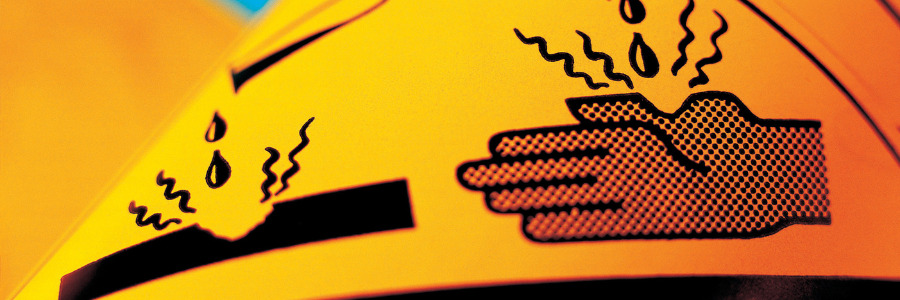What is WHMIS?
By: Kim Samela, Client Services Coordinator
SDS, GHS, HAZMAT, WHMIS 2015. The regulatory world is full of acronyms and WHMIS is probably one of the most misspelled ones out there. It may also be, incorrectly listed as:
- WHIMIS,
- WHMS,
- WHIMS
This important regulation plays an essential role in ensuring occupational health and safety is top of mind in workplaces using hazardous chemicals or other hazardous materials.
This article explains all things WHMIS: what it is, why it is important and some of the major components. Read to the end to become a WHMIS expert (and what to do next if you still have questions).
What is WHMIS?
So what exactly is WHMIS? This is a common question Dell Tech receives. WHMIS stands for the Workplace Hazardous Materials Information System. It is the national hazard communication standard for Canadian workplaces.
To become aligned with the Globally Harmonized System of Classification and Labelling of Chemicals, known simply as GHS, updates were made to the WHMIS regulations in 2015. WHMIS 2015 is the current and most up to date version and covers the regulations on workplace health and safety for handling hazardous materials. The Canada Gazette, Part II published the regulations on February 11, 2015 and amendments came into force on December 15, 2022.
Currently, a 3 year transition period (ending December 15, 2025) is available to bring safety data sheets, workplace labels and product classifications into compliance with the amendments put forth in WHMIS 2015.
WHMIS in Canada
Health Canada is the government body responsible for oversight of the Workplace Hazardous Materials Information System. Under their occupational health and safety legislation; WHMIS is regulated by provinces, territories, and federal governments.
Why is WHMIS important?
In short, WHMIS keeps workers safe by educating employers and workers about potential hazards when handling or storing workplace hazardous products.
The purpose of WHMIS 2015 remains the same as when the law first came into effect back in 1988: to ensure both employers and their employees receive reliable and consistent occupational health and safety information about chemicals and other the hazardous products intended for use in the workplace.
The standards in place require employers to provide WHMIS education to staff so appropriate precautions can be taken when handling hazardous products and chemicals.
What are the different elements of WHMIS?
There are 4 key elements to WHMIS 2015.
1: Hazard Identification and Classification
Hazardous products can fall into 2 major groups which can be found below:
- Physical: this is based on chemical and/or physical properties such as flammability, corrosivity to metals and reactivity.
- Health: determined on possible health effects like respiratory sensitization, eye irritation and/or cancer causing or carcinogen risks
The two major groups are then further divided into hazard classes which includes at least one category. Categories are assigned a number to advise how hazardous the product is. Category 1 is always the biggest risk. Categories may be further divided into types which are indicated by letters.
2: Cautionary labeling of containers in both English and Canadian French
There are 2 main types of WHMIS labels:
- Supplier Labels: suppliers must provide a supplier label including all 6 fields for all hazardous products.
- Workplace Labels: required if a hazardous product is produced, transferred to another container and used in the workplace. Workplace labels must have these 3 minimum requirements:
- Product Identifier Name
- Safe Handling Details
- Reference to the Safety Data Sheet
Signal words and pictograms with a distinctive red border may be present on labels compliant with WHMIS 2015 to quickly show users what types of hazards they should be aware of. There are many classes and categories that do not require a pictogram however.
3: The requirement for Safety Data Sheets (SDS), formerly known as MSDS or Material Safety Data Sheet.
Safety data sheets provide more information about a specific product including identification, physical and health hazards, safety precautions for storage, handling and what to do in an emergency such as a spill, fire or for first aid.
The standard format includes 16 sections in a specific order. They should be readily available for staff to reference and yes must be provided in both English and Canadian French. If you need safety data sheets, Dell Tech can author them for you.
4: Worker Education and Training
Employers are required by law to provide training to all staff who could come in contact with hazardous products through normal work activities such as maintenance, emergencies, disposal, storing or normal use as well as any workers who supervisor or manage employees who could be exposed or are involved in emergency response.
Employers are required to keep education and training records.
It is the employee’s responsibility to participate in training and take any necessary steps to protect themselves.
How Dell Tech Can Help with WHMIS Compliance
Under WHMIS 2015, employers who manufacture, sell, distribute, import or use hazardous materials into the country are required by Health Canada to be compliant with all requirements. Dell Tech offers many services that help ensure compliance such as:
- hazard materials classification
- flammability and hazard classification testing
- providing GHS label requirements
- safety data sheet authoring
- expertise on worker education and training
- guidance on current requirements under WHMIS 2015 and navigating what that means for your company and specific products
- customized training programs for your staff
If you have any questions regarding WHMIS 2015 requirements in Canada, do not hesitate to reach out to us!
For More Information, Contact Our Team:
Kim Samela
Client Services Coordinator
519-858-5021
kim@delltech.com
Dell Tech has provided professional, confidential consulting services to the specialty chemical
industry in Canada, the USA, Europe, and Asia for the last 40 years.
Contact us today for more information.







